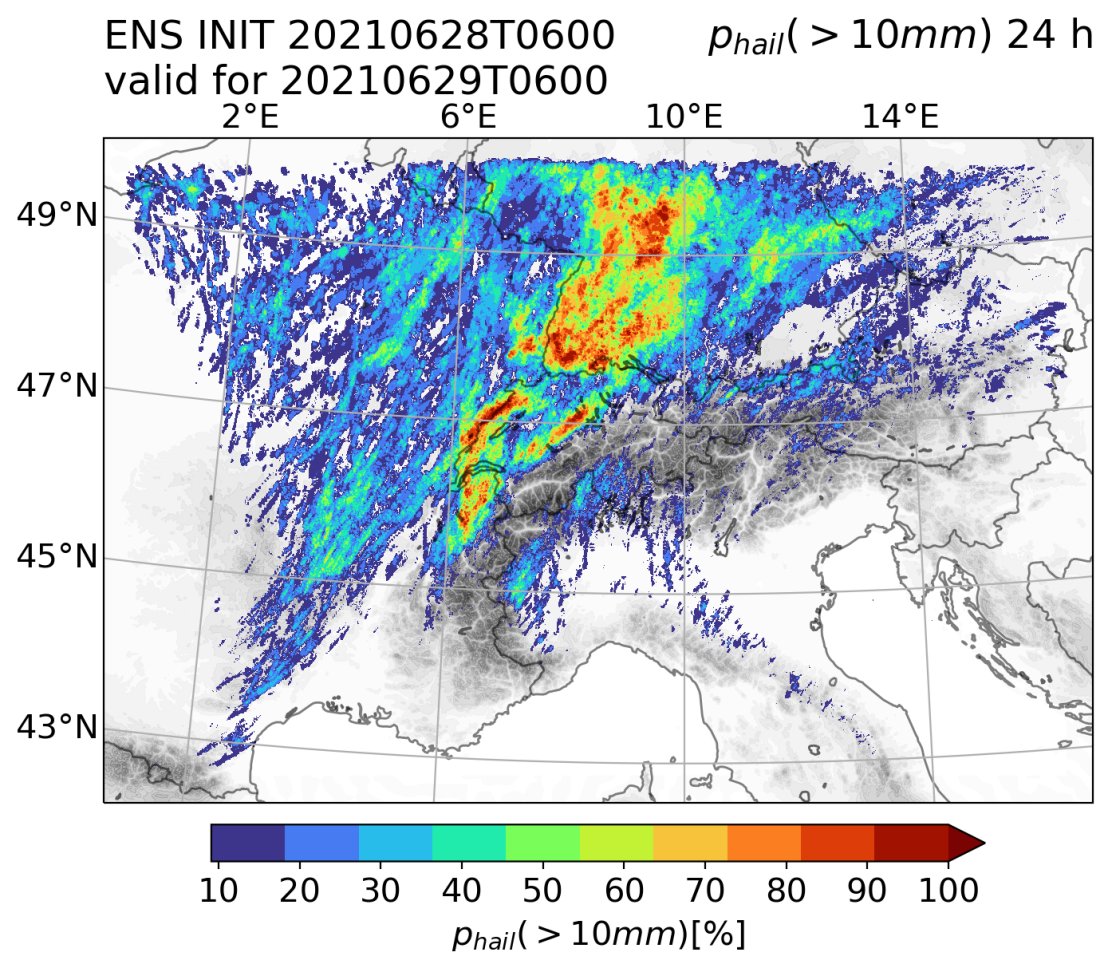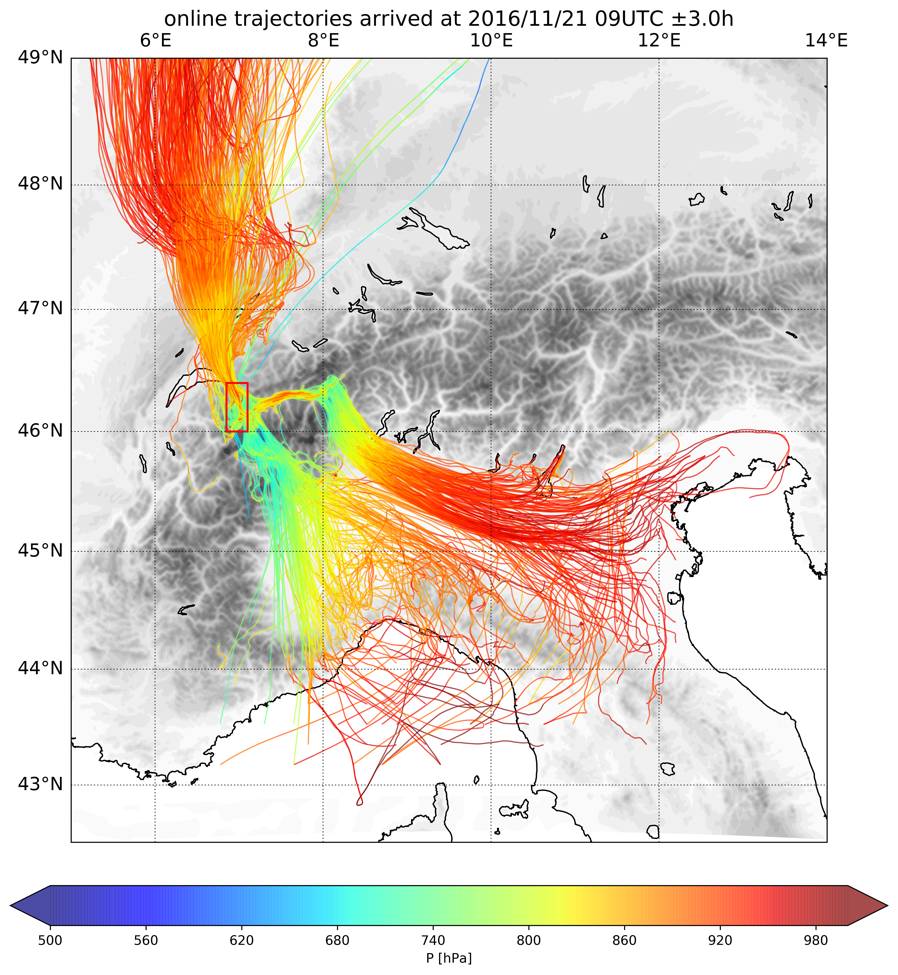Alpine weather and climate
The weather and climate in central Europe is strongly influenced by the Alps. For instance, the mean precipitation in Central Europe clearly reflects the outline of the Alpine barrier, or heavy precipitation is triggered by the mountainous barrier. Furthermore, many wind systems, e.g., foehn, are directly linked to the complex topography of the Alps, with many inner-Alpine valleys and mountain ridges. Of course, this complexity also has its impact on the predictability of Alpine weather, and hence poses a particular challenge for NWP models.
The research in our group during the recent few years has addressed several aspects of Alpine meteorology. First, floods are among the most damaging natural hazards in the Alpine regions. They are caused by heavy precipitation events which are often strongly affected by orographic effects. The dynamics of such events is studied in great detail in our group. In particular we consider the role and link of the different temporal and spatial scales (synoptic, meso and micro) and how they lead to flooding events. Second, we investigate how the airstreams impinging on the Alpine barrier are affected, e.g., whether they are horizontally deflected (orographic blocking) or surmount the Alpine crest. This flow regime strongly influences, e.g., the spatial pattern of precipitation and is also decisive in the formation of lee-cyclones in the gulf of Genoa or Mistral jets between the western Alps and the Massif Central. Third, foehn winds affect both the northern and southern parts of Switzerland. We study both the climatological aspects of foehn flow in the Alpine valleys, and also the physical processes related to foehn dynamics, thermodynamics and predictability. Finally, in a fourth research topic, hail formation in the Alpine region is considered. Hail cells are tracked in space and time, and their evolution (pathway, intensifying and weakening phases) is studied in detail to determine how it is determined by the complex topographic environment. In addition to the process understanding on hail formation, the predictability of hail cells in complex topography is investigated based on ensemble NWP simulations, and the expected changes of hail tracks, intensities and spatial frequencies in a warming climate are assessed.
The group is addressing the overall goals listed above in several complementary ways: climatological studies based on NWP (ensemble) forecast and reanalysis data sets are used to compile extensive climatologies, e.g., of foehn flows under varying synoptic conditions. More process-oriented research is based on high-resolution numerical modeling, in particular with the COSMO NWP model, and it relies also extensively on our Lagrangian analysis tool LAGRANTO. Multi-year COSMO simulations under present-day and future climate conditions are used to assess how weather and climate in the Alpine change in a warming climate.
The senior scientist working in this research area and their core themes are Michael Sprenger (orographic blocking and foehn dynamics), Iris Thurnherr (high-resolution weather and climate COSMO simulations), Ellina Agayar (hail and heavy precipitation), and Ruoyi Cui (hail and heavy precipitation).
The PhD projects conducted in this research area are outlined below:
Hailstorms in high-resolution regional weather and climate simulations

Killian Brennan
Severe convective storms can be devastating atmospheric phenomena accompanied by destructive hail. Hail is among the costliest atmospheric phenomena in mid-latitudes as it causes extensive damage to agriculture, buildings, and cars.
Convective storms are inherently difficult to forecast, as many convoluted processes govern their initiation and development on the micro, meso, and synoptic scales.
Several approaches exist to forecasting hail on different spatial and temporal scales. A probabilistic, convection resolving numerical weather model coupled with a one-dimensional hail growth parameterization can fill the gap between the very short-term observation-based high-resolution nowcasting methods and assessing potential synoptically-driven convective storm conditions. To this end, ensemble simulations of recent hailstorms in Switzerland will be simulated with the COSMO and ICON models in the operational ensemble setup as used by MeteoSwiss.
Using a tracking algorithm developed within the scope of this project, which addresses the many challenges associated with tracking hailstorms in output from numerical simulations, a novel, storm-relative analysis of supercell convective environments and hail cell structure is possible. The hail cell tracking method will also be incorporated into the parent project scClim (SNF Sinergia project), which aims to seamlessly couple weather predictions and climate simulations with hail impact assessments in multiple sectors.
Further, within the scope of scClim, the hail-track data will be used to perform feature-based model verifications against observational data and applied to future climate simulations with COSMO to assess potential climate change effects on hail in Switzerland.
Supervised by Heini Wernli and Michael Sprenger.

Lagrangian analysis of Foehn flows in the Alpine region
Lukas Jansing
Foehn is an archetypal downslope wind phenomenon that is typically characterized by its gusty nature combined with a rapid temperature increase and dry air masses. It leads to strong societal impacts (e.g. enhanced risk for forest fires) and has, therefore, been in the focus of meteorological research since the nineteenth century. Important questions that arise are: Which processes are responsible for the Foehn air warming? What causes the descent of air masses into the valleys? What is the influence of the topography and how does it interact with the flow? These questions are at best partly answered and no all-encompassing Foehn theory has been established so far.
This project readdresses the long-standing research questions using several recent technical developments: Foehn flows are simulated for a number of case studies using the latest version of the limited-area model external pageCOSMOcall_made at 1 km horizontal resolution in combination with online trajectories that are calculated with the wind field at every native model timestep. Online trajectories offer the possibility to study atmospheric flow over complex terrain with much greater detail. Furthermore, tracing the temperature tendencies due to all diabatic processes (cloud microphysical processes involving phase transitions, turbulent mixing, radiative flux convergence) allows for a quantification of the total diabatic contribution as well as the role of individual processes for the total Foehn air warming.
Supervised by Michael Sprenger
